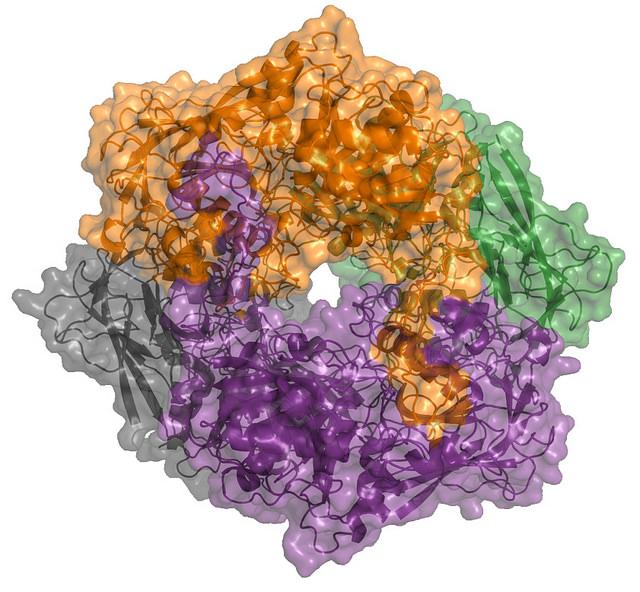Closer look at microorganism provides insight on carbon cycling

An Argonne/University of Tennessee research team reconstructed the crystal structure of BAP, a protein involved in the process by which marine archaea release carbon, to determine how it functioned, as well as its larger role in carbon cycling in marine sediments. Research was performed at the Advanced Photon Source and the Advanced Protein Characterization Facility. Image courtesy Andrzej Joachimiak/Argonne National Laboratory
Researchers from the U.S. Department of Energy's Argonne National Laboratory and the University of Tennessee found that microorganisms called archaea living in marine sediments use completely novel enzymes to break down organic matter into carbon dioxide.
These single-celled archaea eat organic carbon in marine sediments. Enzymes in the archaea break down large carbon molecules into smaller units. This process releases carbon dioxide and methane into the water and eventually, into the atmosphere.
However, as the temperature of oceans and bodies of freshwater increases, this carbon cycling process accelerates. The temperature at the bottom of the ocean, for example, is approximately two to four degrees Celsius (35 to 39 degrees Fahrenheit). According to Andrzej Joachimiak, Argonne distinguished fellow and director of the Structural Biology Center, if the ocean temperature rises one or two degrees, the rate of carbon release might increase.
“About 40 percent of Earth's organic carbon is stored in marine sediments,” Joachimiak said. “An increase in temperature and acceleration of the carbon cycling process in these sediments is a major concern.”
Joachimiak said scientists are uncertain about how fast archaea process carbon and whether the release is accelerating. Once researchers have these statistics, they may find ways to better predict the environment's response to a changing climate.
This understanding starts at the molecular level. Using resources at the Advanced Photon Source, a DOE Office of Science User Facility, and the Advanced Protein Characterization Facility, the research team produced and crystallized bathyaminopeptidase, or BAP – one of the enzymes found in the archaea – to look into its structure and observe how it operates. They found that BAP plays an important role in breaking down proteins and, consequently, the turnover of atmospheric carbon.
The biggest challenge the researchers had was determining BAP's function, because no previously cultured organisms shared a close ancestry. These types of organisms are considered microbial “dark matter” because their physiologies are unknown and they have never been grown in a lab.
And because it is difficult to study their physiologies, scientists cannot determine their precise impact on ecosystems and major global events. For example, BAP was found to be structurally similar to the known amino acid ester hydrolase, but had evolved to serve an entirely different function.
Despite this challenge, the researchers demonstrated that detailed characterization of enzymes from microbial dark matter can be done without first having to grow those organisms in the lab, which may be difficult or time-consuming.
“Being able to characterize proteins directly from microbial dark matter, without requiring that they first be grown in a lab, opens up limitless possibilities for discovering novel functions of these strange organisms that control the breakdown of carbon in marine sediments,” said Karen Lloyd, assistant professor in the department of microbiology at the University of Tennessee.
According to Karolina Michalska, assistant protein crystallographer in the Biosciences Division, it was originally believed that bacteria were the primary players in the degradation of proteins in marine sediments. But the research shows that archaea are also involved in the process.
“It seems that archaea have a larger role in organic carbon, or protein, degradation than we previously realized,” Michalska said.
The study, “New aminopeptidase from 'microbial dark matter' archaeon,” was published June 10 in The FASEB Journal. The research was supported by the U.S. Department of Energy's Office of Science, by the U.S. National Institutes of Health and by the Center for Dark Energy Biosphere Investigations led by the University of Southern California. Studies were performed at the 19-Insertion Device Beamline, operated by the Structural Biology Center at the Advanced Photon Source at Argonne, and at Argonne's Advanced Protein Characterization Facility.
Argonne National Laboratory seeks solutions to pressing national problems in science and technology. The nation's first national laboratory, Argonne conducts leading-edge basic and applied scientific research in virtually every scientific discipline. Argonne researchers work closely with researchers from hundreds of companies, universities, and federal, state and municipal agencies to help them solve their specific problems, advance America's scientific leadership and prepare the nation for a better future. With employees from more than 60 nations, Argonne is managed by UChicago Argonne, LLC for the U.S. Department of Energy's Office of Science.
The Office of Science is the single largest supporter of basic research in the physical sciences in the United States, and is working to address some of the most pressing challenges of our time. For more information, please visit science.energy.gov.
Media Contact
All latest news from the category: Life Sciences and Chemistry
Articles and reports from the Life Sciences and chemistry area deal with applied and basic research into modern biology, chemistry and human medicine.
Valuable information can be found on a range of life sciences fields including bacteriology, biochemistry, bionics, bioinformatics, biophysics, biotechnology, genetics, geobotany, human biology, marine biology, microbiology, molecular biology, cellular biology, zoology, bioinorganic chemistry, microchemistry and environmental chemistry.
Newest articles

NASA: Mystery of life’s handedness deepens
The mystery of why life uses molecules with specific orientations has deepened with a NASA-funded discovery that RNA — a key molecule thought to have potentially held the instructions for…

What are the effects of historic lithium mining on water quality?
Study reveals low levels of common contaminants but high levels of other elements in waters associated with an abandoned lithium mine. Lithium ore and mining waste from a historic lithium…

Quantum-inspired design boosts efficiency of heat-to-electricity conversion
Rice engineers take unconventional route to improving thermophotovoltaic systems. Researchers at Rice University have found a new way to improve a key element of thermophotovoltaic (TPV) systems, which convert heat…



